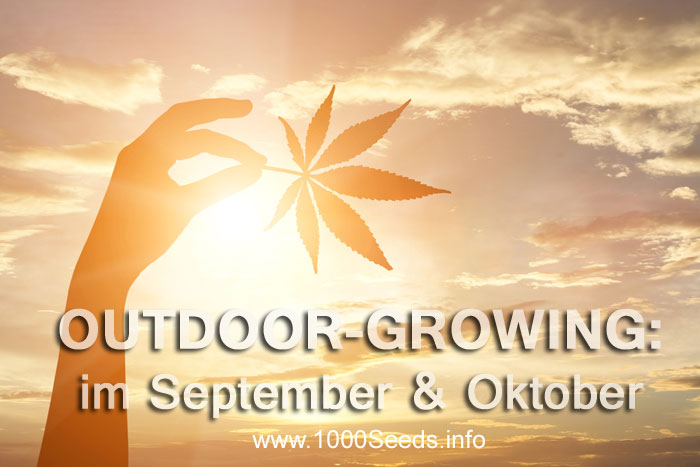September and October are exciting months for the outdoor grower. The precious flowers start to really take shape, become stickier and start to ripen. In September the flowers pump up, the cannabis plants now need an increased amount of phosphorus and potassium to form the buds. Organic growers use Seabird Guano as a top dressing that contains a high amount of phosphorus and potassium. It is sprinkled on the soil around the plants and only superficially mixed into the soil. Additions with seaweed and algae also help to increase the density of the flowers and trichome development. It is advisable to apply fertiliser in smaller quantities and several times a week instead of a large portion at once.
With increasing flower size and thus increasing weight of the buds, it may be necessary to support the plants and flowers to prevent premature breakage and harvest losses. At this point, stopping development by breaking would be fatal.
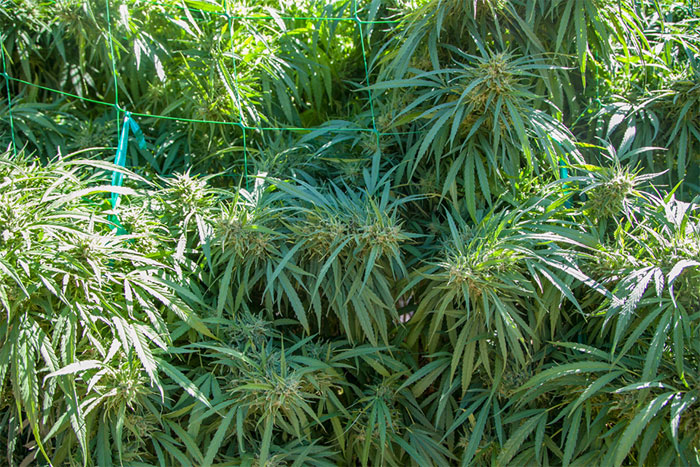
The bigger the buds become, the more danger there is of them being attacked by mould and fungal diseases. Therefore, you should keep a close eye on the plants. Especially in the 3rd and 4th week of flowering, the risk of mould is very high. From then on, the circulation in the flowers is lower and moisture can more easily stay inside the flower. If the climate is warm and humid or even cold and humid, certain fungi can spread quickly and destroy large parts or the entire crop. Cannabis plants should be protected from too much rain if possible. Infected, withered or badly damaged leaves should be removed, also from the soil, to avoid the development and spread of diseases.
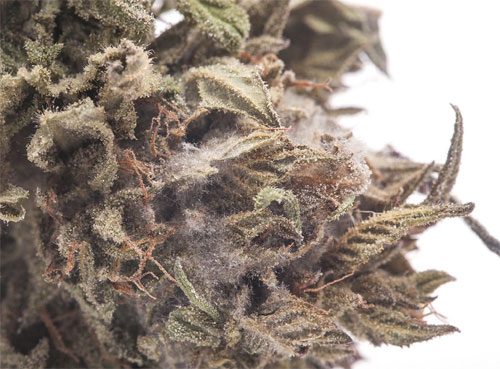
Botrytis in the flowers is best prevented beforehand. Once it is there, it spreads quickly and often makes the harvest inedible. Conspicuous blossoms should be generously cut away immediately.
Small areas infested with mildew or mould can, if you are lucky, be brought under control by spraying with water and a few drops of peppermint and rosemary oil. If the plant is more severely infested, it must be removed so as not to endanger others.
Clones and cannabis plants that have already been grown indoors and were healthy and vigorous when released into the wild will produce the greatest yields. A well-organised harvest with a little background knowledge rounds things off and leads to the desired result: the highly potent aromatic buds to fly away. With a little knowledge about the processes in the cannabis plant during harvesting and already before, the medicinal effect and quality can be fully preserved.
As the cannabis plant matures in autumn, the cannabinoid content also increases. The right harvest time is crucial to get the desired medicinal or psychoactive effects. The THC content in the flowers is highest when the plant is fully ripe. Many growers therefore choose to harvest only then. Some growers, or if the weather throws a spanner in the works, harvest as early as 45-50 days of flowering. However, a significant loss in the content of the various cannabinoids and thus the potency must be expected. You can find out how to determine the right time to harvest here: Harvest guide 1: When is the ideal time to harvest?
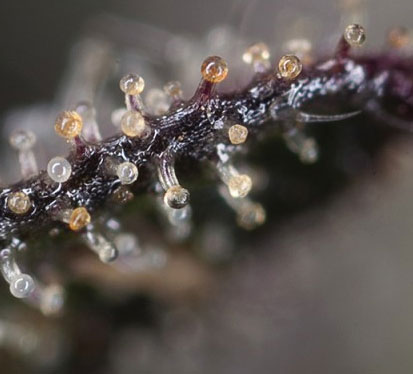
more than half of the trichomes have turned amber, the plant is perfect for harvesting
The majority of cannabinoids including THC can be found in the resin glands that cover the flowers and small leaves. Smaller amounts are found on the surface of the stems and in the inner cells of the plant.
The male plants contain a vanishingly small amount of cannabinoids compared to the female plants. Usually they are not harvested in this context, because this has already been done before, if one grows with regular seeds. Unfertilised (non-pollinated) female cannabis plants that have not produced seeds reach the highest amount of resin glands and cannabinoids when they are mature. When harvested, the flowers are separated from the leaves and stems, dried and processed.
At the right time of harvest, the cannabis plants stop growing, the THC content is at its maximum and cannot increase any further. In the course of the harvesting process and during drying, the cannabinoids are converted from their inactive form to their active form. During the drying process, a large amount of water disappears from the flowers and plant parts and thus also a large part of the weight. The cannabinoid content remains the same or is reduced. Proper handling of the flowers and careful drying and storage are key to preserving potency and cannabinoids.
This should be prevented because it could damage the resin glands and the potency of the flowers:
- unnecessary touching of the flowers
- Temperatures above 26° C
- Humidity too high
- Sun rays/light on the harvested buds
- Contrary to the widely held belief that hanging plants upside down would cause cannabinoids to migrate to the tips, cannabinoids do not move to other parts of the plant. However, hanging the plants upside down still makes sense because it ensures good ventilation of large plants during the drying process and it is a space-saving way to dry them.
Buds washing
Washing buds after harvesting is becoming more and more popular. Similar to washing fruits and vegetables before consumption, this is also done with fresh cannabis flowers. THC, cannabinoids and terpenes are not lost in the process, as they are not water-soluble. The buds are washed in a mild H²O² solution, which (partially) removes bacteria, pests, impurities and dust. Of course, one should proceed carefully in order not to endanger the resin glands. Scrubbing the flowers vigorously is absolutely not the best decision. Always use fresh and absolutely pure water for washing. A short water bath is sufficient.
Move the buds to a well-ventilated area immediately after the bath.
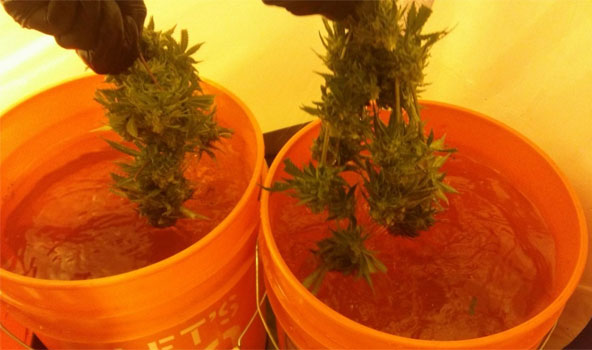
Before the outdoor harvest
2-3 days before the outdoor harvest, the cannabis plants should no longer be watered. The soil around the plants should be well dried. This can shorten the overall drying time without affecting the quality of the buds.
Cannabis plants that have been exposed to rather harsh weather during flowering, with a lot of wind, rain or high heat, can often have a diminished aroma. This is always preceded by destruction or insufficient formation of terpenes. This happens more easily with outdoor growing than with indoor growing, where the climate can be controlled much more.
Contaminants on the outdoor plant and its flowers can also cause a change in the taste of the buds later on. If the temperatures are too high during cultivation and then during harvest, there is an increased volatilisation of terpenes.
Drying the flowers too quickly and hot can also cause a loss of flavour. Drying too quickly does not allow the chlorophyll to be broken down sufficiently, and as a result, the flowers have a scratchy and diminished flavour when smoked.
If cannabis is stored and dried too moist, like in a compost, then a degrading process starts, which can be accompanied by a hay-like to chemical taste.
Without laboratory analysis and a microscope, powdery mildew and other pathogens are often impossible to detect. These pathogens weaken the marijuana plants and can also affect the taste. Bacteria, small dead insects and other contaminants on the surface of the flowers remain present even when they are harvested.
Washing the fresh flowers with a pure H2O2 bath can remove impurities to a large extent.
Clean cannabis flowers smell, clean, fresh and are full of pure cannabis aromas. Some strains have a genetic predisposition for rather less aromas and intense smells. This has the advantage that these strains are less noticeable outdoors and do not come to the fore with extreme smells.
Outdoor cannabis plant rinse
To avoid the bad taste that fertiliser residues can cause in plants, the cannabis plants should be rinsed before harvesting. At least 10-14 days before harvesting, the planting medium is "flooded" with clear pure water (pH 7.0) or osmosis water and watered only with this. Special additives like Final Flush especially help to remove fertiliser residues from the plants.
The outdoor harvest depends a lot on the weather. If the summer lasts long and the bad weather comes late, the cannabis plants can reach full maturity and produce remarkable results. If the weather is worse, wet and rather cold, many growers are forced to harvest earlier. As long as there is still enough sunlight, not all drowning in water or serious signs of disease, and the temperatures are high enough, you can still leave the plants and wait until they are really ripe. It always depends on your climate.
Large outdoor plants can be harvested in up to 4 stages. Harvesting 2-4 times in a period of 2-6 weeks on a very large plant can increase the harvest weight by up to 40%. It is important to know that not all flowers of a plant have the same amount of THC and other cannabinoids. Not all flowers of a plant are ripe at the same time. The ones further down usually take longer. If you harvest in several stages, the lower flowers get more light and can develop fully in this way. This method is particularly suitable if the summer lasts a long time.
Legendarily, and because it is much better, cannabis plants are harvested in the early morning. At this time, the THC content in the plant is at its peak.
Buds trim and manicure
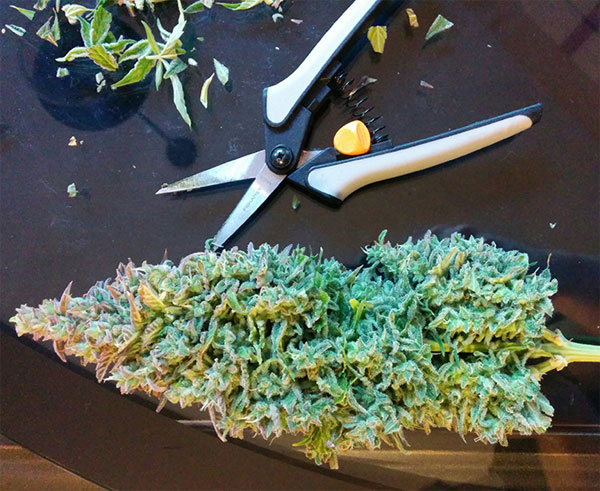
This is how it works:
- Cut off plant at the bottom of the main stem
- Remove all large leaves
- cut the cannabis plant into individual branches
- remove large and medium-sized leaves from each branch
- carefully remove the small bud leaves with pointed scissors, shape buds
- Hang branches to dry or place on a drying rack
In my opinion, manicuring and trimming the buds is easiest right after harvesting. The harvest room should be kept at a humidity of 45-50%, which is best. If the larger and smaller leaves are trimmed now, the drying time is shortened.
For trimming the buds one should use several Trimming shears, Pruner and Pruner ready. Also, cleaning charcoal for the scissors. Nitrilio gloves can prevent your hands from getting all sticky early on and keep you harvesting.
If you soak the scissors, clippers and pruners in ethanol every now and then during harvesting and clean them with it, you can let it evaporate later and have a certain amount of your own cannabis oil besides, instead of extremely gummed up tools.
By trimming over a micronet such as the 00-Table, the resin crystals can be collected. Under the micronet, the cannabinoid-rich resin can then be scraped together and pressed into hash in blocks.
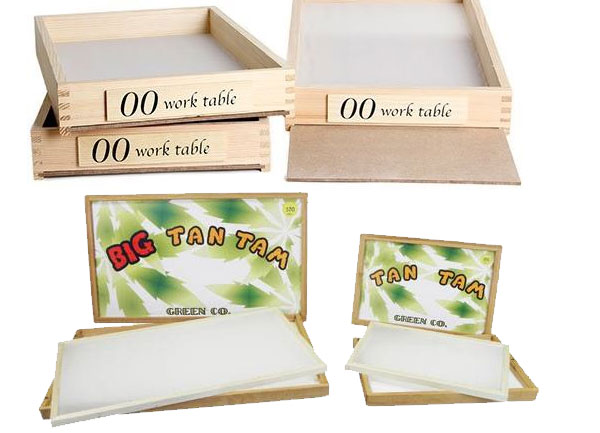
The 00 work-table and the Big Tan Tam allow the production of own very high quality hashish
Latex or nitrile gloves can be more easily freed from resin by placing them in the freezer for an hour. It is best to allow enough time for harvesting. Depending on the size of the plant, it can take a long time.
Depending on the variety and climate conditions, we can probably look forward to the first finished (non-automatic) cannabis plants from mid to late September. Some early Indicas are already ready then. In colder regions, this can take longer.
Further detailed information on the topic Harvest time, Harvest, Drying andstorage you can read in our Harvest guide.






